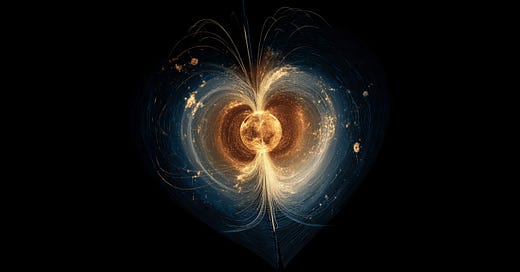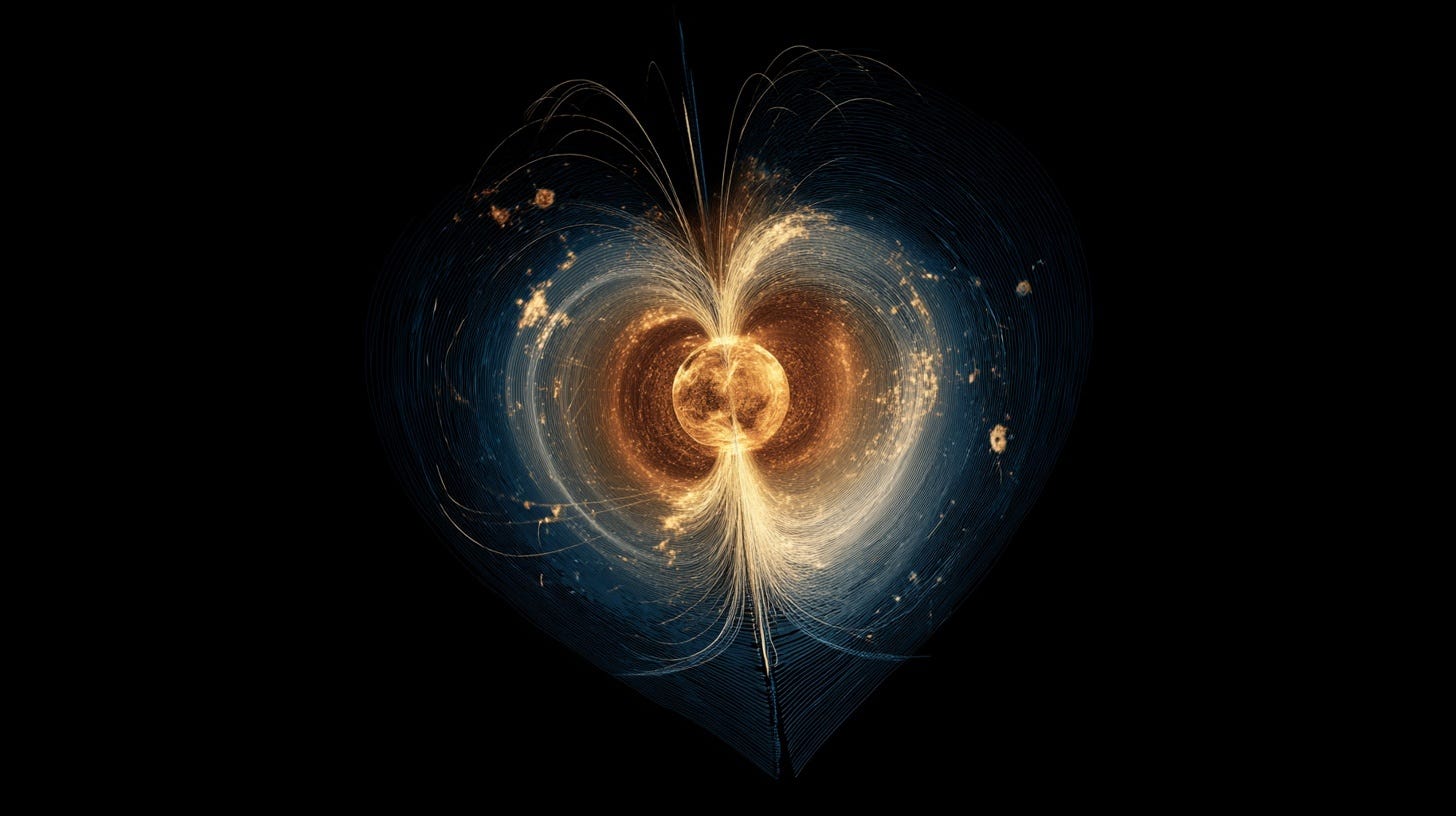The heart is the beginning of life, the sun of the microcosm... the foundation of life, and author of all.
William Harvey
Spotlight of the week
Within the heart’s muscular walls are about 40,000 neurons – a “little brain” that senses and remembers. But even more astonishing is the heart’s electromagnetic field: with each beat, the heart generates an electric and magnetic field that radiates outward. This field is about 60 times stronger electrically and up to 5,000 times stronger magnetically than the brain’s field Instruments can detect a person’s heart energy several feet away, and when people are in close proximity, one heart’s rhythms can subtly influence another’s. Through a lifetime it will beat ~3 billion times, loyally pushing life’s blood through 60,000 miles of vessels. It is strong (outputting enough pressure to spray blood feet high) yet sensitive (responding to our slightest anxieties and joys). It can literally break – stress cardiomyopathy or “broken heart syndrome” – and it can exuberantly soar (the racing heart of excitement). We now transplant hearts, implant mechanical ones, and even regrow pieces of heart tissue in labs. But we also know that a person is much more than a replaceable pump. The stories of transplant patients who inherit quirky preferences or memories from their donors remain medically puzzling, hinting at the heart’s mysteries. After all, as the poet Rumi wrote, your heart knows the way. Run in that direction.
This Week in Technology
Robots Learn to Think Ahead
Packing a suitcase or stacking warehouse shelves might soon be second nature to robots. A new MIT/NVIDIA algorithm lets robots “imagine” thousands of possible moves in parallel, then hone the best plan – all in the blink of an eye. Instead of slowly testing one action at a time, the robot’s brain now flashes through myriad scenarios at once, powered by fast graphics processors. The result is a dramatic speed-up: manipulation problems that once took minutes or hours to solve can be figured out in seconds. In tight industrial spaces, this means a machine could swiftly decide how to fit different-shaped items together without collisions or damage. By giving robots a kind of foresight, engineers are bringing a touch of human-like packing savvy to our mechanical helpers – no more clumsy pauses, just efficient, almost thoughtful motion.
Read More
Altman’s Gentle Singularity
OpenAI’s Sam Altman is urging us to fear not the future. In a recent message to an anxious world, he paints a vision of a “gentle” AI-driven singularity where wonders emerge smoothly and prosperity accelerates for everyone. He imagines a 2030 with intelligence and energy in abundant supply, unlocking solutions once out of reach. Yes, whole classes of jobs may vanish, but Altman insists society will quickly grow richer and adapt, creating new roles and “assimilating new tools” as we always have. His optimism portrays superintelligence not as an abrupt apocalypse, but as a dawn of routine miracles – though some wonder if this rosy timeline might be too ideal to trust.
Read More
AI Guides the Calm Before the Storm
Google DeepMind has unveiled a breakthrough AI that may help tame nature’s fiercest tempests. This experimental system conjures up 15-day hurricane forecasts in mere minutes, predicting both a cyclone’s wandering path and its fury with unprecedented accuracy. Its skill at foreseeing storm intensity – a longtime meteorological blind spot – even outshines top traditional models, a feat once thought beyond machine learning. In partnership with U.S. hurricane officials, this fast, “thinking” model will stream its insights to human forecasters, heralding a new era where AI and experts weave better warnings to shield millions in harm’s way.
Read More
AI “Researcher” Passes a Chemistry Test
San Francisco start-up FutureHouse has debuted ether0, an AI they call the first true “reasoning model” for science. This open-source AI learned chemistry not from textbooks, but by taking a half-million practice questions, teaching itself to think through problems and even design new molecules in plain language. Ether0 can show its step-by-step logic as it solves complex questions, a peek inside the usual “black box” of AI reasoning. In tests it outperformed cutting-edge models (even GPT-4) on tricky chemistry puzzles, hinting at a future where AI co-pilots lab work from hypothesis to discovery.
Read More
Tune in while you read
This Week in Health
Ocean’s Janitor Finds a Cure
The lowly sea cucumber, known as a “janitor” of the ocean floor, may also become a guardian of human health. Researchers discovered a unique sugar molecule in these creatures that blocks a key enzyme (Sulf-2) which cancer cells use to spread. Unlike some existing drugs, this sea cucumber sugar fights tumor growth without causing dangerous bleeding, a common side effect when targeting such enzymes. It’s a cleaner, marine-inspired approach to cancer therapy: the compound breaks down tumor defenses but doesn’t interfere with blood clottings. While we can’t harvest enough sea cucumbers for medicine, the next step is to synthesize this molecule in the lab – a challenge scientists are eager to tackle. This discovery highlights nature’s pharmacy under the waves, offering hope that future cancer treatments might be brewed from the sea’s hidden remedies.
Read More
Electric fields target a brain tumor in this concept illustration.
A new alliance of treatments is scoring wins against one of the deadliest cancers. At USC, doctors combined an electric-field therapy (Tumor Treating Fields) with immunotherapy and chemo to attack glioblastoma brain tumors from all sides. In an early trial, this trio boosted patient survival by ~70%, with those who had inoperable tumors living significantly longer than expected. By helping the immune system finally penetrate the brain’s protective barriers, this approach is giving new hope to families fighting a cancer once deemed nearly undefeatable.
Read More
Nanoparticles Deliver Genetic Medicine to Lungs
Illustration of genetic medicine (DNA strands) delivered via the bloodstream. Scientists unveiled a “breath” of fresh air in treating lung disease – tiny nanoparticles carrying healing genes. An Oregon State team engineered a new lipid nanoparticle system that can safely ferry mRNA and gene-editing tools directly into hard-to-reach lung cells. In mice, one version delivered a cancer-fighting gene that slowed lung tumors, while another fixed the faulty gene behind cystic fibrosis and improved lung function.This targeted therapy platform not only avoids toxic side effects but also promises to transform care for stubborn respiratory illnesses by repairing them at the molecular root.
Read More
The heart is a thousand-stringed instrument that can only be tuned with love.
Hafiz
This Week in Science
Mining the Moon for Treasure
An astronomical fortune may be lying under the moon’s dusty craters. Scientists estimate that over $1 trillion worth of platinum and other precious metals, deposited by ancient asteroids, are waiting to be mined on the lunar surface. By scanning 1.3 million craters, researchers identified about 6,500 likely loaded with platinum-rich ore, making our moon a tempting target for extraterrestrial prospectors. The idea isn’t merely to get rich – proponents argue that selling these space resources could fund our expansion into the solar system. Technically, digging on the moon is easier than chasing down asteroids, but legal stardust clouds the vision: the 1967 Outer Space Treaty forbids nations from claiming celestial bodies. Still, loopholes and new agreements (like the Artemis Accords) hint at a looming moon rush, with the U.S. and China seemingly in a quiet race to see who will tap that cosmic wellspring first. What was once science fiction – lunar miners striking it rich – is inching closer to reality, fueled by equal parts ingenuity and astro-ambition.
Read More
Self-Healing Green Hydrogen Tech
Korean researchers have given green hydrogen a jolt of inspiration with self-healing electrodes that make clean fuel production cheaper and more durable. Water electrolysis usually relies on pricey platinum catalysts that corrode over time, but this team built an electrode using only nickel – and a clever trick to renew itself. During operation, they apply brief “rest” periods with a weak voltage, which lets dissolved iron in the solution magically re-deposit onto the electrode’s surface. The iron and nickel bond into a fresh catalytic layer, repairing any damage and maintaining performance. This catalyst-free, self-rejuvenating design promises to slash costs and extend the life of hydrogen-producing cells, bringing truly sustainable fuel one step closer. It’s technology that quietly heals itself – and with it, perhaps a piece of the planet.
Read More
A Plastic That Melts into Nature
In a Japanese lab, scientists have created a new plastic that vanishes in seawater within hours, leaving nothing harmful behind. This innovative material, as strong as conventional plastic, dissolves into its basic components when exposed to salt, and ocean bacteria eagerly dine on the leftovers. In a demo, a clear sheet of the polymer disappeared in salty water in about an hour – and even in soil, it breaks down completely in just a few days. Importantly, it produces no microplastics, no toxic residue, and doesn’t even release CO₂ as it degrades. With industry interest mounting, the team is perfecting a protective coating to make it viable for real-world products. It’s a glimpse of a future where our plastics could simply return to nature’s embrace – a breakthrough against pollution born from the duty to leave a cleaner world for our children.
Read More
Editors Choice of the Week
In the 1970s, artist Allan Kaprow turned something deeply personal – the heartbeat – into a shared artistic experience. His work Time Pieces invited participants to sit together and literally feel each other’s pulses and breathing, creating an intimate human connection through synchronized vital signs. What started as a clinical-sounding exercise (counting heartbeats, timing breaths) blossomed into an exploration of empathy and awareness: a gentle reminder that our internal rhythms carry emotional meaning. Kaprow believed that by consciously sharing these “microcosms of life,” people could tap into a profound sense of togetherness and self-discovery. Decades later, his interoceptive art still resonates as a poetic union of health and creativity – turning the quiet beat of a heart into a powerful symbol of human unity.
Read More
Did you see…? Apple’s Liquid Glass Makeover. At its core is Liquid Glass, a translucent, fluid interface material that shimmers and shifts dynamically with your content.
Did you think…? that anime could take on a philosophical soul? Philosopher Mike Benett finds that anime has become a profound medium for grappling with life’s biggest questions. Citing classics like Ghost in the Shell and Millennium Actress, Benett shows how anime builds worlds where the self is fluid, technology blurs reality, and personal evolution takes center stage.
Did you hear…? innovations are in the air? A new analysis of historical inventions suggests that great minds of do think alike. Brian Potter examined 190 major inventions from 1800–1970 and found that over half had multiple people, in different places, inventing the same thing around the same time. Such a high rate of multiple discovery hints that progress is guided less by lone geniuses and more by the zeitgeist of an era.
Did you read…? embracing the unknown? Philosopher Brett Hall dives into the paradox of “known unknowns,” exploring how acknowledging what we don’t know is key to creating new knowledge. By understanding the contours of our uncertainty, we lay the groundwork for breakthroughs that once seemed out of reach.
Closing the loop with a beautiful heartful combination of Rumi and Confucius only from the heart can you touch the sky so wherever you go, go with all your heart.
xxx
FusionNote
Because the future is brighter when we build it together, I’d love your help—whether that’s sharing stories, suggesting breakthroughs, or simply adding a drop of your own creativity to our cosmic cauldron. Let’s fuse knowledge, wonder, and hope into something beautiful.
















Share this post